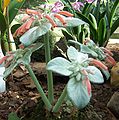Sinningia
| Sinningia subsp. var. | Gloxinia | |||||||||||||||||||||||||||||||||||||||||||||||||||||||
|---|---|---|---|---|---|---|---|---|---|---|---|---|---|---|---|---|---|---|---|---|---|---|---|---|---|---|---|---|---|---|---|---|---|---|---|---|---|---|---|---|---|---|---|---|---|---|---|---|---|---|---|---|---|---|---|---|

|
|
| ||||||||||||||||||||||||||||||||||||||||||||||||||||||
| ||||||||||||||||||||||||||||||||||||||||||||||||||||||||
Sinningia (pronounced /sɨˈnɪndʒiə/)[1] is a genus of flowering plants in the family Gesneriaceae. There are about 65 species of tuberous perennial herbs, all occurring in Central America and South America, with the greatest concentration of species occurring in southern Brazil.
The best-known species, Sinningia speciosa, was originally introduced to cultivation as Gloxinia speciosa and is still commonly known to gardeners and in the horticultural trade as "gloxinia". The true genus Gloxinia is distinguished by having scaly rhizomes rather than tubers.
Sinningia species often grow on rocks or cliffs and most are pollinated by hummingbirds or bees but Sinningia brasiliensis is bat-pollinated, and Sinningia tubiflora, with large, powerfully fragrant tubular white flowers, is apparently pollinated by sphinx moths. Most of the species have large, brightly colored flowers because of this, numerous species and a large number of hybrids and cultivars are cultivated as houseplants. Some species with particularly large tubers are cultivated by cactus and succulent enthusiasts as caudiciforms. One such example is Sinningia leucotricha, often listed under the older name Rechsteineria leucotricha and dubbed "Brazilian edelweiss" for its covering of silvery, silky hairs. Other species with large tubers are Sinningia iarae, Sinningia lineata, and Sinningia macropoda.
| Standard Cyclopedia of Horticulture |
|---|
|
Sinningia (for Wilhelm Sinning, gardener at the University of Bonn). Including Dolichodeira, Ligeria, and Rosanowia. Gesneriaceae. Tropical herbs with handsome tubular flowers, of glasshouse culture; includes the florists' gloxinia. Pubescent or villous, from a tuberous rhizome: lvs. opposite, usually large, petioled; the floral ones reduced to bracts: fls. usually large, solitary or fascicled in the axils, pedicelled; calyx-tube shortly and broadly turbinate, adnate, 5-angled or 5-winged, the limb foliaceous, broadly 5-cleft or -parted; corolla-tube nearly equal at the base or the posterior gibbous, long or broadly cylindrical, the upper part swollen or bell-shaped; lobes 5, spreading, or the 2 posterior smaller; stamens included, attached to the tube of the corolla; anthers broad, the cells confluent at the apex; glands of the disk 5, distinct, or the 2 posterior more crowded together or connate; ovary half inferior; style dilated at the tip; stigma concave, entire or slightly 2-lobed. —Species 20-25, Brazil. Allied to Gesnera, Isoloma, and Achimenes, and of similar cultural requirements. The genus includes the cult. gloxinia, which is properly Sinningia speciosa, Benth. & Hook., but which is treated in this book under Gloxinia. Other than this species, the sinningias are little known horticulturally, although some of the species have much merit. CH
|
Cultivation
Propagation
Pests and diseases
Species
- Sinningia aggregata
- Sinningia brasiliensis
- Sinningia canescens
- Sinningia cardinalis
- Sinningia cooperi
- Sinningia iarae
- Sinningia incarnata
- Sinningia leucotricha
- Sinningia lineata
- Sinningia macropoda
- Sinningia × pumila
- Sinningia speciosa
- Sinningia tubiflora
The Brazilian genera Paliavana and Vanhouttea, consisting of shrubby plants without tubers, are closely related to Sinningia and recent morphological and molecular analyses (Boggan 1991, Perret et al. 2003) suggest that these genera are, in fact, nontuberous Sinningia species. All three genera were included in tribe Gloxinieae in the classification system of Hans Wiehler but are now recognized in their own tribe, Sinningieae.
Numerous genera, including Corytholoma, Rechsteineria and Lietzia, have been synonymized under Sinningia.
Gallery
References
- ↑ Sunset Western Garden Book, 1995:606–607
External links
- w:Sinningia. Some of the material on this page may be from Wikipedia, under the Creative Commons license.
- Sinningia QR Code (Size 50, 100, 200, 500)


